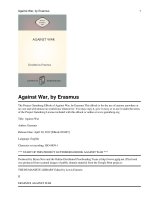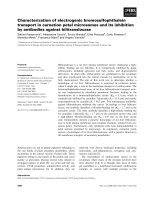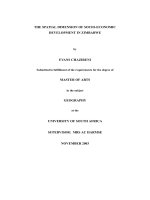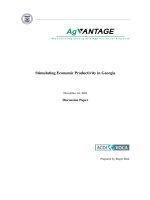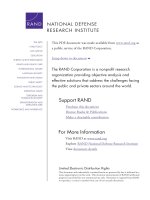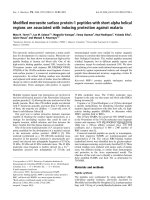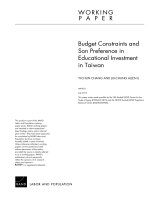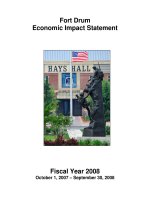Chinese Economic Coercion Against Taiwan docx
Bạn đang xem bản rút gọn của tài liệu. Xem và tải ngay bản đầy đủ của tài liệu tại đây (1.13 MB, 180 trang )
This document and trademark(s) contained herein are protected by law as indicated in a
notice appearing later in this work. This electronic representation of RAND intellectual
property is provided for non-commercial use only. Permission is required from RAND
to reproduce, or reuse in another form, any of our research documents.
Limited Electronic Distribution Rights
Visit RAND at www.rand.org
Explore RAND National Defense Research Institute
View document details
For More Information
Purchase this document
Browse Books & Publications
Make a charitable contribution
Support RAND
This PDF document was made available from www.rand.org as
a public service of the RAND Corporation.
6
Jump down to document
The RAND Corporation is a nonprofit research
organization providing objective analysis and
effective solutions that address the challenges facing
the public and private sectors around the world.
THE ARTS
CHILD POLICY
CIVIL JUSTICE
EDUCATION
ENERGY AND ENVIRONMENT
HEALTH AND HEALTH CARE
INTERNATIONAL AFFAIRS
NATIONAL SECURITY
POPULATION AND AGING
PUBLIC SAFETY
SCIENCE AND TECHNOLOGY
SUBSTANCE ABUSE
TERRORISM AND
HOMELAND SECURITY
TRANSPORTATION AND
INFRASTRUCTURE
WORKFORCE AND WORKPLACE
This product is part of the RAND Corporation monograph series. RAND
monographs present major research findings that address the challenges facing
the public and private sectors. All RAND monographs undergo rigorous peer
review to ensure high standards for research quality and objectivity.
Chinese Economic Coercion
Against Taiwan
A Tricky Weapon to Use
Murray Scot Tanner
Prepared for the Office of the Secretary of Defense
Approved for public release; distribution unlimited
The RAND Corporation is a nonprofit research organization providing
objective analysis and effective solutions that address the challenges
facing the public and private sectors around the world. RAND’s
publications do not necessarily reflect the opinions of its research clients
and sponsors.
R
®
is a registered trademark.
© Copyright 2007 RAND Corporation
All rights reserved. No part of this book may be reproduced in any
form by any electronic or mechanical means (including photocopying,
recording, or information storage and retrieval) without permission in
writing from RAND.
Published 2007 by the RAND Corporation
1776 Main Street, P.O. Box 2138, Santa Monica, CA 90407-2138
1200 South Hayes Street, Arlington, VA 22202-5050
4570 Fifth Avenue, Suite 600, Pittsburgh, PA 15213-2665
RAND URL: />To order RAND documents or to obtain additional information, contact
Distribution Services: Telephone: (310) 451-7002;
Fax: (310) 451-6915; Email:
Library of Congress Cataloging-in-Publication Data
Tanner, Murray Scot.
Chinese economic coercion against Taiwan : a tricky weapon to use /
Murray Scot Tanner.
p. cm.
Includes bibliographical references.
ISBN 978-0-8330-3969-9 (pbk. : alk. paper)
1. China—Foreign economic relations—Taiwan. 2. China—Foreign relations—
Taiwan. 3. Taiwan—Foreign economic relations—China. 4. Taiwan—Foreign
relations—China. I. Title.
HF1604.T36 2006
337.5105124'9—dc22
2006033995
Cover Design by Eileen Delson La Russo
The research described in this report was prepared for the Office of the
Secretary of Defense (OSD). The research was conducted in the RAND
National Defense Research Institute, a federally funded research and
development center sponsored by the OSD, the Joint Staff, the Unified
Combatant Commands, the Department of the Navy, the Marine Corps,
the defense agencies, and the defense Intelligence Community under
Contract DASW01-01-C-0004.
Cover Illustration by Tim Lee, Care of theiSpot.com
iii
Preface
is monograph analyzes the political impact of the rapidly growing economic rela-
tionship between the People’s Republic of China (PRC) and Taiwan and evaluates the
prospects for Beijing to exploit that expanding economic relationship to employ eco-
nomic coercion against Taiwan. It also identifies China’s goals for applying economic
pressure against Taiwan. To establish a framework for evaluating China’s relative suc-
cess or failure in using economic coercion against Taiwan, this work draws upon the
conclusions of the large and empirically rich body of studies of economic diplomacy
that have focused on economic coercion and trade sanctions.
In examining Taiwan’s response to the rising cross-strait economic relationship,
the study analyzes Taipei’s two decade–long effort to strike a difficult balance between
two goals:
limiting excessive dependence on mainland China that could be exploited for
political pressure
taking advantage of China’s explosive economic development to improve Taiwan’s
eroding economic competitive position.
A large portion of this monograph is devoted to evaluating the cross-strait eco-
nomic relationship and Taiwan’s potential economic vulnerability to Chinese efforts to
cut off or disrupt key aspects of that relationship. But this document also extensively
analyzes the challenges that China has faced in its efforts to convert this raw, potential
economic influence into effective political leverage.
is work closes with an overall evaluation of the cross-strait relationship and
Taiwan’s vulnerability to a variety of scenarios for economic pressure—some of
which Beijing has actually attempted in recent years, and some of which are as yet
only hypothetical or threatened. It also briefly discusses the potential impact of cross-
strait economic diplomacy on U.S. policy interests in the Taiwan Strait. As such, this
monograph should be of interest to policymakers, analysts, and others interested in
U.S. policy toward Asia.
is research was conducted within the Intelligence Policy Center of the RAND
National Defense Research Institute, a federally funded research and development
•
•
iv Chinese Economic Coercion Against Taiwan: A Tricky Weapon to Use
center sponsored by the Office of the Secretary of Defense, the Joint Staff, the Unified
Combatant Commands, the Department of the Navy, the Marine Corps, the defense
agencies, and the defense Intelligence Community.
For more information on RAND’s Intelligence Policy Center, contact the Direc-
tor, John Parachini. He can be reached by email at ; by
phone at 703-413-1100, extension 5579; or by mail at the RAND Corporation, 1200
South Hayes Street, Arlington, Virginia 22202-5050. More information about RAND
is available at www.rand.org.
Contents
v
Preface iii
Figures
ix
Tables
xi
Summary
xiii
Acknowledgments
xvii
Abbreviations
xix
CHAPTER ONE
Introduction 1
Potential for Economic Coercion
1
Purpose of is Study
5
Organization of is Monograph
8
CHAPTER TWO
Economic Coercion: Factors Affecting Success and Failure 11
Defining Economic Coercion/Economic Pressure
11
Mainland Chinese Economic Pressure: Serving Many Political Goals
13
Forcing Policy Change
13
Destabilizing, Subverting, or Creating Domestic Pressure on the Target Regime
14
International Signaling
15
Domestic Political Symbolism
15
Punishment and Eroding Military Power
16
Likely Scenarios for Chinese Economic Coercion Against Taiwan
16
Export Sanctions
17
Import Sanctions
17
Financial and Investment Sanctions
17
Selective Harassment or Intimidation of Taiwan Businesspeople
17
Economic Disruption, Damage, and Sabotage
18
Deliberate Slowing or Withholding of Business
19
Efforts to Hasten the “Marginalization” or “Hollowing Out” of Taiwan’s Economy
19
Factors Affecting Success and Failure of Economic Coercion Against Taiwan
19
vi Chinese Economic Coercion Against Taiwan: A Tricky Weapon to Use
Economic Factors at Help Determine Success or Failure 20
Levels of Economic Pain and Disruption
20
Political Factors at Help Determine Success or Failure
22
China and Taiwan’s Bitter Historical Relationship
23
Beijing’s Specific Demands
23
Efforts to Subvert or Change Taiwan’s Government
25
Likely Issues in a Beijing-Taipei Economic Confrontation
27
e Target State’s Political Capacity to Resist Coercion
28
Beijing’s Quest for “Conduits of Influence” Within Taiwan Politics
29
Domestic Politics in the Initiating State
30
International Support for the Initiating and Target Countries
31
CHAPTER THREE
Taiwan’s Struggle to Manage Expanding Cross-Strait Economic Ties 33
Key Conclusions: Taipei’s Powerful Dilemmas in Controlling Cross-Strait Trade
and Investment
33
Taiwan’s Major Policies Designed to Limit Mainland Influence
36
Beijing’s Initial Entreaties to Taiwan
36
Taiwan’s Response: From Full Embargo to Rapid Opening
38
Shifting Investment Patterns and Rising Concerns About Dependence
42
Taipei’s Rising Concerns About Growing High-Tech Investment
43
Encouraging Diversification: President Lee’s “Go South” Policy
45
Tightening Administrative Oversight and Controls: “No Haste, Be Patient”
47
Cross-Strait Economic Ties Under Chen Shui-bian
50
From ”No Haste, Be Patient” to “Active Opening, Effective Management”
50
e “Mini-ree Links”
54
Continuing Support for Diversification
54
Restricting Flows of Mainlanders to Taiwan
55
Financial Markets
56
Using Technological Limitations and Recent Semiconductor Business
57
Ongoing Battles over the Full ree Links
60
Business and Opposition Party Reactions
62
Holiday Direct Flights
66
Conclusion: Overall Evaluations of Taiwan’s Government Policy
68
CHAPTER FOUR
Economic Factors: Evaluating Taiwan’s Vulnerability 73
Main Findings
74
e Rapid Expansion of Cross-Strait Trade and Investment
76
Cross-Strait Trade
76
Cross-Strait Investment: Enormous, but Just How Enormous?
77
Contents vii
Gauging the Importance of Cross-Strait Economic Relations to Taiwan’s Economy 82
e Strategic Significance of Current Cross-Strait Economic Ties
87
e Rising Importance of Mainland-Based Production: e Information Technology
Sector
88
Strategic Resources: Vulnerability to Cutoff
90
Vulnerability to Deliberate Economic Disruption: Stock Markets
91
Disruption of Taiwan’s Information Networks
96
Coda: China’s Economic Dependence on Taiwan
97
Conclusion: Putting Taiwan’s Economic Vulnerability in Perspective
99
CHAPTER FIVE
Political Factors: Converting Economic Influence into Political Leverage 103
Political Factors Influencing the Success or Failure of Economic Pressure
103
Domestic Politics and eir Influence on Economic Coercion
104
Major Findings: Obstacles to Beijing’s Political Leverage
104
Turning Economic Influence into Political Leverage: Beijing’s Strategies
105
Seeking Conduits of Influence in Taiwan
106
Public Opinion: Economic Closeness, but Political Drift
107
Neutralizing Potential Leverage: e Shifting Center of Taiwan’s Elite Politics
109
e “Taishang”: Business as the Key Conduit for Beijing’s Influence?
111
Beijing’s Questionable Assumptions About the Taishang
112
Beijing’s Efforts to Leverage the Taishang
113
e 1990s: Private Reassurance
113
e 2000 Taiwan Presidential Election: Turning Up the Heat
114
Failed Regime Change: e Taishang in the 2004 Elections
118
e “Taiwan Spy” Case: “Killing the Chicken . . . ”
118
Chen’s Reelection and Beijing’s Frustration
120
DPP Counterattack: Neutralizing Taishang Influence
120
Fleeing Pressure from Two Sides: Learning to “Fly Below the Radar”
123
Assessing the Taishang’s Opposition to Chen
124
Beijing Rethinks Economic Leverage, Spring 2004
126
Back on the Attack: e Hsu Wenlong Case, May 2004
127
Beijing’s Counterproductive Strategy Toward the Taishang
132
e Impact of Economic Pressure on Mainland Chinese Politics
132
CHAPTER SIX
China’s Economic Leverage: A Powerful Weapon, but Tricky to Use 135
Taiwan’s Rising “Asymmetric Interdependence” with Mainland China
135
Taiwan’s Struggle Between Growth and Excessive Dependence
136
Taiwan’s Vulnerability to Specific Coercion Scenarios
137
Mainland Economic Vulnerabilities
140
viii Chinese Economic Coercion Against Taiwan: A Tricky Weapon to Use
Beijing’s Challenges: Converting Economic Influence into Political Leverage 141
Potential Risks for U.S. Interests: Beijing’s Frustrations and Taipei’s Fears
142
Bibliography
145
Figures
ix
4.1. Cross-Strait Trade 1990–2005 77
4.2. Taiwan’s Total Exports as a Percentage of GNP, 1991–2005
83
4.3. Cross-Strait Trade as a Percentage of Taiwan’s Total Trade
84
4.4. Cross-Strait Imports as a Percentage of Taiwan’s Total Imports
85
4.5. Cross-Strait Exports as a Percentage of Taiwan’s Total Exports
86
Tables
xi
4.1. Taiwan-Approved Foreign Direct Investment in China and Selected
ASEAN Countries, 1986–1994
78
4.2. Percentage of Selected Taiwan IT Products Produced in
Mainland China, 2004
89
xiii
Summary
is monograph analyzes the rapidly expanding economic relationship between main-
land China and Taiwan and the prospects and challenges Beijing faces as it tries to
exploit this economic relationship to gain political leverage over Taipei.
Since the early 1980s, the economic relationship between Taiwan and mainland
China has exploded, driven by far-reaching economic and political reforms on both
sides as well as powerful natural complementarities in the two economies. As a result,
the two economies are now in a deep, wide-ranging relationship of “asymmetric inter-
dependence” in which each side relies upon the other for important contributions to its
economy, and each would suffer great economic pain and dislocation in the event of a
major disruption in that relationship. But as Taipei’s leaders have long feared, Taiwan
depends on the mainland market for a far higher percentage and a far broader range of
its economic activities than the mainland depends on Taiwan.
From virtually no contact a quarter-century ago, by late 2001, China had replaced
the United States as Taiwan’s number-one market for its exports. Cross-strait two-way
trade has risen from an estimated $950 million (U.S.) in 1986 to more than $46.3 bil-
lion by the end of 2003, the latter figure being equal to 17.1 percent of Taiwan’s total
trade. China is also the number-one venue for Taiwan’s foreign investment and the
number-one production base for many of its most profitable exports—especially its
information technology (IT) exports. Cross-strait economic ties now occupy terrific
weight within both economies, particularly Taiwan’s. Exports to the mainland equaled
more than one-tenth of Taiwan’s entire gross national product (GNP) by the end of
2003. Taiwan’s foreign direct investment (FDI) in the mainland accounts for more
than half of all Taiwan FDI—or perhaps much more than half.
e expanding cross-strait relationship raises serious security questions, particu-
larly for Taiwan. Many analysts have expressed concern that China will exploit the
economic relationship with Taiwan in ways that could undermine the United States’
long-standing opposition to either side unilaterally or coercively altering the status
quo across the Taiwan Strait and its insistence that any resolution to cross-strait con-
flict be acceptable to the people of Taiwan. Beijing has, in fact, either committed or
publicly contemplated many forms of economic pressure against Taiwan at various
times within the past two decades. Beijing has openly proclaimed that its key goals for
xiv Chinese Economic Coercion Against Taiwan: A Tricky Weapon to Use
expanding economic relations with Taiwan include encouraging “peaceful reunifica-
tion” and “using business to pressure politicians.” Over the years, Chinese leaders and
analysts have often argued that cultivating economic ties with Taiwan might contrib-
ute to reunification in many ways, from the magnetic to the highly coercive.
Economic experts warn that if China were able to close down key parts of the
cross-strait economic relationship, Taiwan would be vulnerable to a major recession
and other severe forms of economic dislocation. e hundreds of thousands of Taiwan
businesspeople now working on the mainland are also vulnerable to pressure and
harassment from mainland authorities. In addition, China has demonstrated that it
can disrupt key sectors of Taiwan’s economy, including its stock markets and informa-
tion networks.
Since 1979, successive Taipei governments have struggled to strike a balance
between growth and security in their cross-strait economic policies. Both government
and business leaders strongly desire to draw on mainland China’s rapid growth as a
vehicle to rescue Taiwan’s increasingly challenged international competitive position.
At the same time, both the Lee Teng-hui and Chen Shui-bian administrations have
sought to limit Taiwan’s economic dependency on Beijing. Politically, advocates of lib-
eralizing cross-strait trade and investment relations—in particular, Taiwan’s influential
mainland-invested business community (the “Taishang”)—have won the lion’s share
of these battles. Presidents Lee and Chen, however, have periodically shown real will-
ingness to resist such pressure and can point to some significant successes in limiting
Taiwan’s dependence—most notably in slowing the pace of high-tech investment on
the mainland and maintaining a significant technological “gap” or “lag” between what
Taiwan firms produce on the island and what they produce across the strait. Taipei’s
efforts to get Taishang to move their investments to less-threatening Asian venues have
been far less successful.
Most experts on economic diplomacy agree, however, that the level of economic
deprivation an “initiating” country (e.g., mainland China) can inflict rarely, by itself,
determines the effectiveness of economic coercion. Several political factors—in par-
ticular the domestic political situation within the initiating and “target” countries—
usually have a greater impact on the initiator’s ability to convert economic influence into
political leverage. For Beijing to initiate economic pressure, a key challenge is identify-
ing and effectively exploiting “conduits of influence” within the target’s (e.g., Taiwan’s)
political system—that is, politically influential classes or groups in Taiwan with a stake
in promoting the policies that Beijing also supports. ese conduits of influence are a
key factor in converting economic influence into effective political leverage.
Somewhat surprisingly, given the high level of Taiwan’s economic dependence
on the mainland, these economic ties have not automatically translated into effective
political leverage for China. Indeed, in recent years, Beijing has often been frustrated
in its efforts to exploit this economic leverage, at least in the near term. From Chi-
na’s perspective, the cross-strait economic relationship is potentially a very powerful
Summary xv
political weapon, but it is a weapon that Beijing is finding increasingly tricky to use.
For example,
Beijing’s frustration was dramatically illustrated in the 2004 Taiwan presidential
election. e elections proved that widespread forecasts that Taiwan’s business
leaders and Taiwan voters—both worried about the poor state of Taiwan’s econ-
omy and anxious for expanded cross-strait economic relations—would combine
to defeat President Chen Shui-bian were mistaken or at least badly exaggerated.
A major reason why Beijing is having trouble exploiting its economic leverage is
that most Taiwan businesspeople have become highly adept at “flying below the
radar” politically—keeping their true political inclinations and activities hidden
from political leaders in both Taiwan and mainland China, thereby frustrating
Beijing’s efforts to pressure them into forming a ready-made “lobby” for Bei-
jing’s interests. While mainland-invested Taiwan businesspeople have been, for
the most part, successful in encouraging their government to loosen economic
restrictions on cross-strait ties, the business community has been unwilling or
unable to use its political influence to pressure Taipei into making significant
political concessions to Beijing.
Taiwan’s voters have also frustrated Beijing’s forecasters. Although the voters have
largely supported candidates who favored improved cross-strait economic ties, it
has not prevented the continuous slide in support for reunification with China on
terms that Beijing prefers.
Nor have Taiwan’s political leaders sat back passively as Beijing attempted to
exploit its burgeoning economic might. President Chen has frequently shown
himself to be fairly adept at politically disarming or counterattacking many advo-
cates of a more rapid opening up of cross-strait relations.
Finally, China must reflect upon the potential blowback that large-scale efforts at
economic coercion against Taiwan might have upon its own economy and soci-
ety. Although Taiwan is, overall, more economically dependent upon mainland
China than China is on Taiwan, there are key regions and sectors of China’s econ-
omy that are enormously dependent upon Taiwan investment, and these would
likely suffer very badly in the event of a serious cutoff of trade and investment.
But Beijing’s difficulty in translating economic leverage into political leverage is
not necessarily good news for either Taiwan or for U.S. interests in the region. ere is
significant evidence that in the wake of the 2004 Taiwan presidential election, China’s
growing frustration over its problems in employing economic levers of power tem-
porarily undermined the position of those policy advisors who were most optimistic
about the long-term efficacy of economic power and cross-strait economic integra-
tion—and perhaps correspondingly strengthened the hands of those Chinese analysts
who advocate using more nakedly coercive measures against Taiwan. ese tensions
•
•
•
•
•
xvi Chinese Economic Coercion Against Taiwan: A Tricky Weapon to Use
have eased in the past year as Beijing adopted a more restrained, seductive strategy
toward Taiwan, and Chen Shui-bian has encountered numerous political setbacks at
home. But Chinese analysts overwhelmingly attribute Chen’s problems to factors other
than the power of the growing cross-strait economic relationship.
Taipei’s fears about cross-strait economic relations may also increase threats to
stability in the region. Many in Taipei do not share this report’s conclusion that Beijing
is having difficulty transforming its economic influence into political leverage. Fearing
that Beijing’s rapid economic growth will eventually grant it overwhelming political
leverage, many of Taiwan’s more strongly pro-independence leaders believe that the
time to push for constitutional reforms or other measures to formalize a more indepen-
dent relationship is “now or never.”
is study indicates that, for Beijing, there is an irony in its efforts to exploit its
economic leverage to bring Taiwan closer to a reunification deal. Cross-strait economic
links appear to have the greatest impact on Taiwan’s politics when Beijing is least
aggressive in trying to exploit them, as it has been since early 2005. When Beijing uses
high-profile, high-pressure economic tactics, they have tended to backfire, creating
powerful opposition in Taiwan and undermining the political effectiveness of those
with a stake in closer cross-strait economic and political ties. Taiwan business and
political leaders seem more inclined to reflect positively on the importance of future
cross-strait economic relations when Beijing keeps a low profile and refrains from
overt pressure tactics. But when Beijing’s leaders have become frustrated with Taipei’s
“envelope-pushing,” they all too often see the Taishang as a convenient target for their
momentary wrath. e Beijing leadership—by attacking one of the few groups left in
Taiwan with a reasonably positive impression of it—has, in the words of an old Chi-
nese saying, “lifted a rock only to drop it on its own foot.” China has at its disposal a
potentially powerful weapon to keep Taiwan from drifting away. But there is serious
doubt whether Beijing’s leaders have the political self-restraint to use this weapon effec-
tively over the long run. Whenever Beijing has grown irritated with Taipei, Taiwan
businesspeople operating in China have made exceedingly tempting targets.
xvii
Acknowledgments
e author would like to express his deep gratitude to many individuals for their
assistance in preparing this monograph. My former RAND colleagues James C.
Mulvenon, Michael S. Chase, and Kevin L. Pollpeter provided very generous assistance
in planning the study, arranging interviews, providing source materials, commenting
on draft chapters, and allowing this author to draw extensively on the data in their
excellent report, Shanghaied? e Economic and Political Implications of the Flow of
Information Technology and Investment Across the Taiwan Strait (2004), as the basis for
sections of Chapters ree and Four. Shelley Rigger of Davidson College and Keith
Crane of RAND provided extremely detailed and thought-provoking critiques of the
draft report. e author also benefited from discussions with Kenneth G. Lieberthal
of the University of Michigan, Richard C. Bush III of the Brookings Institution,
Chu-yuan Cheng of Ball State University, and Phillip C. Saunders of National Defense
University. Eric Valko provided excellent Chinese-language research assistance and
aided with the author’s interviews in Beijing. Rupert J. Hammond-Chambers
and the staff of the U.S Taiwan Business Council provided great assistance in arrang-
ing many of the author’s interviews in Taiwan. Donna Boykin and Heather Roy, as
always, provided tremendous logistical and administrative support for this study, and
Abigail Chapman prepared an earlier version of the bibliography. Finally, this study
would not have been possible without the generous cooperation of many experts and
officials in the United States, mainland China, and Taiwan who provided their data
and assessments. Regrettably, their contributions must remain anonymous.
xix
Abbreviations
ASEAN Association of Southeast Asian Nations
ASL Anti-Secession Law
CEO chief executive officer
CNOOC China National Offshore Oil Corporation
COCOM Coordinating Committee for Multilateral Export Controls
CPC China Petroleum Corporation
DOE U.S. Department of Energy
DPP Democratic Progressive Party
EDAC Economic Development Advisory Conference
FDI foreign direct investment
GMD Guomindang
GNP gross national product
IPO initial public offering
IT information technology
LCD liquid crystal display
MAC Mainland Affairs Council
MIC Market Intelligence Center
MIC/III Market Intelligence Center’s Institute for Information Industry
MND Ministry of National Defense
MoEA Ministry of Economic Affairs
xx Chinese Economic Coercion Against Taiwan: A Tricky Weapon to Use
MOFTEC Ministry of Foreign Trade and Economic Cooperation
NDU Taiwan National Defense University
NSB National Security Bureau
NTD New Taiwan Dollar
PC personal computer
PLA People’s Liberation Army
PFP People’s First Party
PRC People’s Republic of China
SARS severe acute respiratory syndrome
SEF Straits Exchange Foundation
TAA Taipei Airlines Association
TFT thin-film transistor
TSMC Taiwan Semiconductor Manufacturing Corporation
TSU Taiwan Solidarity Union
UMC United Microelectronics Corporation
WTO World Trade Organization
1
CHAPTER ONE
Introduction
Potential for Economic Coercion
Economic relations between Taiwan and the People’s Republic of China (PRC) were
virtually nonexistent from 1949—when China’s Guomindang (GMD, the National-
ist Party) government fled the mainland to Taiwan—until 1979, when the Commu-
nist Party embarked upon its historic policy shift toward market-oriented economic
reform and opening to the outside world. roughout this period, Taiwan, motivated
by security concerns, maintained a rigid policy of no economic or political contact
with the mainland. During much of this same period, the PRC leadership under Mao
Zedong was committed to one of the world’s strictest regimes of economic isolation
and autarky. ere were limited, largely underground, indirect trade ties through Hong
Kong (then a British colony) and a few informal trade exchanges between fishermen in
several small Taiwan-controlled islands close to the PRC coast. But beyond these very
modest contacts, both governments feared that extensive economic ties might grant
their adversaries dangerous levels of political leverage, and, thus, they maintained firm
policies of mutual isolation.
Since the early 1980s, however, the cross-strait economic relationship has
exploded, driven by far-reaching economic and political reforms on both sides, as well
as powerful natural complementarities in the two economies. e volume of cross-
strait economic activity has expanded at a terrific pace. From virtually no contact a
quarter-century ago, by late 2001 China had replaced the United States as Taiwan’s
largest export market. China has also become Taiwan’s number-one target for its over-
seas foreign direct investment (FDI)
1
for at least several years. Cross-strait two-way
trade has risen from an estimated $950 million
2
in 1986 to $37.4 billion by the end
of 2002, the latter figure being equal to 15.4 percent of Taiwan’s total trade. With
Beijing’s apparent blessing, Taiwan has maintained a considerable trade surplus
1
Foreign direct investment refers to investment by foreign companies in companies, facilities, and equipment. It
does not include portfolio investments made in stocks or equities.
2
roughout this study, references to dollars or use of the dollar sign ($) refer to U.S. dollars, unless Taiwan’s
currency, the New Taiwan Dollar (NTD), is explicitly noted.
2 Chinese Economic Coercion Against Taiwan: A Tricky Weapon to Use
with China over the past two decades, and China is the principal source of Taiwan’s
overall trade surplus.
e raw volume of trade and growth rate in trade and investment, though impres-
sive, hardly begin to capture the increasing strategic importance of the relationship.
Cross-strait economic ties now occupy a very large “weight” within both economies,
particularly Taiwan’s. Trade and investment with China now constitute a large and
growing percentage of Taiwan’s total FDI and foreign trade and are also very large in
relation to its gross national product (GNP). In qualitative terms, Taiwan and China’s
economies are now deeply intertwined in many of their most important, cutting-edge
economic sectors—in particular their information technology (IT) sectors. e blos-
soming interdependence of the mainland Chinese, Taiwan, and Hong Kong econo-
mies has accelerated the rise of “Greater China” as one of the most vibrant economic
regions in the world.
e expanding cross-strait relationship raises serious security questions, particu-
larly for Taiwan. Many analysts have expressed growing concern that China might be
able to exploit these expanding economic ties as powerful levers of influence to pres-
sure Taiwan politically. ese fears are well captured in the words of Taiwan political
scientist Tung Chen-yuan:
Taiwan’s government feels ill at ease having such a close economic relationship
with its powerful political rival, in part because it fears the flood of Taiwan invest-
ment and trade will make it economically dependent on China, thus undermin-
ing its de facto political independence. In fact, these fears have been triggered and
reinforced by the fact that Beijing explicitly considers cross-Strait economic rela-
tions an important source of political leverage against Taiwan.
3
A number of analysts have argued that China could exploit its economic rela-
tionship in ways that could undermine the United States’ long-standing opposition
to either side unilaterally or coercively altering the status quo across the Taiwan strait
and its insistence that any resolution to cross-strait conflict be acceptable to the people
of Taiwan. Among the chief concerns is the prospect that the PRC could exploit the
burgeoning economic relationship to bring economic and political pressure on Taiwan
in a variety of ways:
Compel Taiwan to engage in negotiations over reunification or other key issues
on a disadvantageous footing.
3
Chen-yuan Tung, “China’s Economic Leverage and Taiwan’s Security Concerns with Respect to Cross-Strait
Economic Relations,” paper presented at the Taiwan Studies Workshop, Fairbank Center, Harvard University,
Cambridge, Mass., May 2003a. See also Chen-yuan Tung, “Cross-Strait Economic Relations: China’s Leverage
and Taiwan’s Vulnerability,” Issues and Studies, Vol. 39, No. 3, September 2003b, pp. 137–175.
•
Introduction 3
Undermine political support in Taiwan for developing and funding adequate self-
defense capabilities.
Pressure politically influential individuals in Taiwan—either economic or politi-
cal elites—into constituting an essentially unwilling domestic lobby for Beijing’s
interests.
Intimidate large portions of the broader Taiwan electorate or key social interest
groups into supporting concessions to Beijing.
Deter Taiwan from undertaking, or compel it to withdraw, important and oth-
erwise popular domestic policies or political system reforms that do not unilater-
ally change the cross-strait status quo, but which Beijing nonetheless opposes as
threatening.
Compel Taiwan’s political or economic leaders to take economic decisions that
would undermine Taiwan’s long-term economic vibrancy or international support
by transferring key activities and resources (including personnel) to the mainland,
or by “marginalizing,” or “hollowing out,” key economic sectors.
Inflict significant and deliberate damage on key Taiwan economic activities (e.g.,
causing major downturns in stock and bond markets, interfering with key infor-
mation networks) or harass Taiwan businesspeople.
ese scenarios for mainland economic coercion are hardly hypothetical. Beijing
has committed or publicly contemplated every one of these scenarios for economic
pressure against Taiwan at some time within the past decade. Indeed, since its first
economic outreach to Taiwan in 1979, Chinese leaders and policy analysts have pub-
licly argued that their main goals for expanding economic relations with Taiwan—in
addition to accelerating China’s own economic growth—include encouraging “peace-
ful reunification.” As several scholars have stressed, Beijing has for years openly pro-
claimed its strategy of “using the people to pressure the officials” (yi min bi guan) and
“using businesspeople to pressure politicians” (yi shang wei zheng).
4
But China’s leaders and policy advisors are far from unified in their estimates
of the utility of economic levers in dealing with Taiwan, and their assessments have
varied over time, depending on how they see the overall state of the relationship. In
their statements and publications over the years, Chinese leaders and analysts have
often argued that cultivating economic ties with Taiwan might contribute to reuni-
fication in many ways. Economic interdependence, they have argued, can support
a full range of strategies for influencing Taiwan—from the magnetic to the coer-
cive. At the most coercive level, mainland Chinese analysts have overtly threatened
4
Chinese analysts have actually used several different versions of these Chinese expressions, each with their
own particular emphasis on how the economic can serve the political. Also, because of the wide meanings of
Chinese characters, these expressions can have multiple meanings. Yi shang wei zheng, for example, can also
mean “using commerce to serve politics.” For a discussion of these strategies, see Chen-yuan Tung, 2003a,
pp. 137–139, and Chen-yuan Tung, 2003b.
•
•
•
•
•
•
